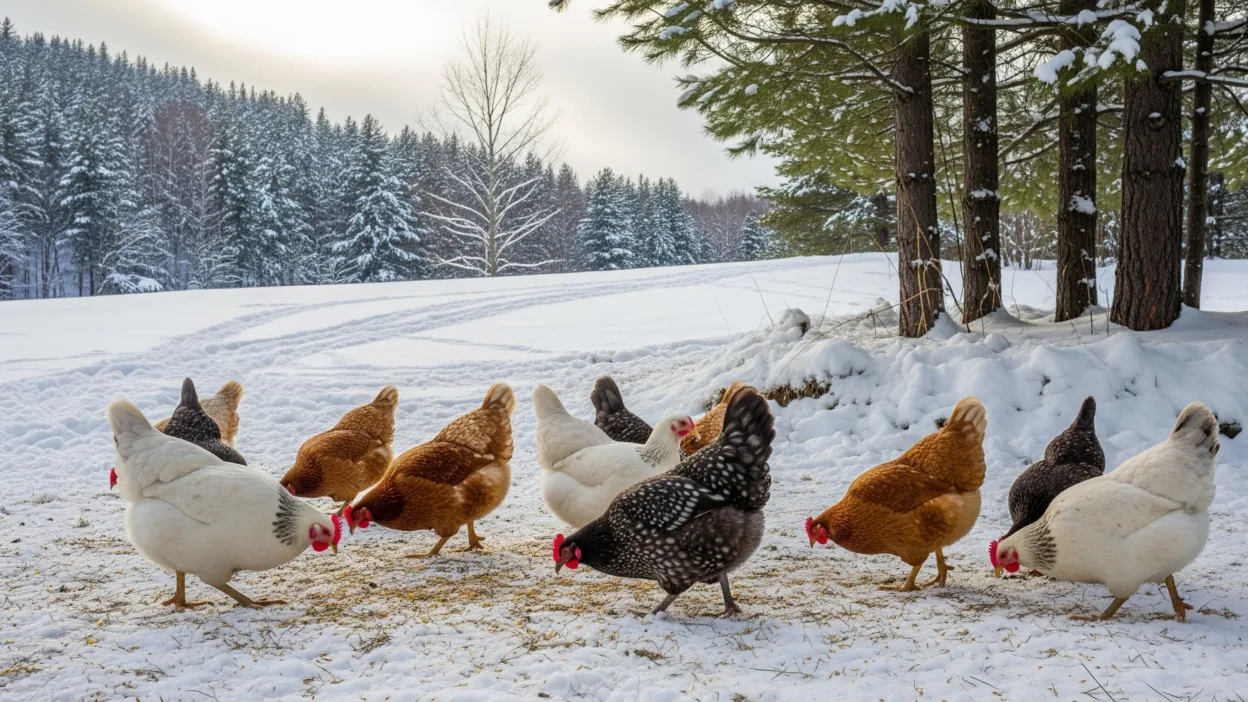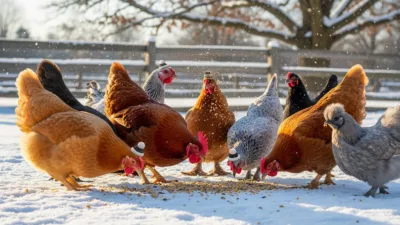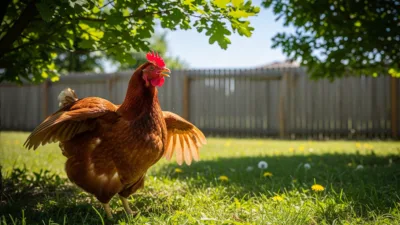Raising backyard chickens in the United States is rewarding, but if you live in a northern state where winters are long, icy, and often brutal, not every chicken breed will thrive. Cold weather can take a toll on flock health and egg production if you choose breeds that aren’t suited for freezing conditions. The good news is that several chicken breeds are naturally cold-hardy, able to withstand snow, wind, and subzero temperatures while still providing a steady supply of eggs.
In this guide, we’ll explore the top cold-hardy hens for northern states, what makes them resilient, and how to care for them through the winter months.
Why Cold-Hardy Chickens Matter in the Northern U.S.
States like Minnesota, Wisconsin, Michigan, Maine, North Dakota, Montana, Vermont, and upstate New York experience some of the harshest winters in the country. Temperatures can stay below freezing for weeks, and snowstorms are common. Chickens that are not bred for these conditions may suffer from frostbite, reduced egg laying, respiratory issues, and stress.
Cold-hardy chickens, on the other hand, have the following traits:
- Smaller combs and wattles to prevent frostbite
- Thicker plumage to insulate against the cold
- Strong laying ability year-round, even in winter
- Adaptability to both confinement and free-ranging
By choosing the right breeds, you’ll save yourself from unnecessary flock losses and keep your backyard homestead productive.
Top Cold-Hardy Hens for Northern States
Let’s look at some of the best chicken breeds suited for cold climates in the U.S. Each of these hens has a reputation for thriving in harsh winters while still being friendly, reliable egg producers.
1. Plymouth Rock (Barred Rock)
One of the most popular dual-purpose breeds in America, Plymouth Rocks are known for their resilience and consistent egg production. Their dense feathers and calm temperament make them excellent for cold-weather flocks.
- Egg Production: 200–250 large brown eggs per year
- Temperament: Friendly, great for families
- Cold Hardiness: Thick plumage protects them well against northern winters
Plymouth Rocks are a reliable choice for both beginner and seasoned chicken keepers in snowy states.
2. Rhode Island Red
A true American classic, Rhode Island Reds are famous for their hardiness and high egg yield. They tolerate confinement well and continue laying even during short, cold winter days.
- Egg Production: 250–300 large brown eggs annually
- Temperament: Active and hardy, sometimes assertive
- Cold Hardiness: Excellent resilience with a strong immune system
This breed is perfect if you want a consistent supply of eggs throughout harsh northern winters.
3. Buff Orpington
Known as the “golden retrievers of the chicken world,” Buff Orpingtons are large, fluffy birds with thick plumage. Their gentle nature and heavy build help them handle cold temperatures exceptionally well.
- Egg Production: 180–220 medium to large brown eggs yearly
- Temperament: Docile, friendly, good with children
- Cold Hardiness: Their thick feathering provides excellent insulation
They’re especially popular in colder regions because of their ability to stay comfortable during freezing nights.
4. Wyandotte
With their rounded bodies and rose combs, Wyandottes are one of the top cold-hardy breeds. Their smaller comb size makes them less susceptible to frostbite, and they come in stunning color varieties like silver-laced and golden-laced.
- Egg Production: 200–240 brown eggs annually
- Temperament: Calm, adaptable, and good foragers
- Cold Hardiness: Excellent, thanks to thick plumage and compact combs
Wyandottes are a favorite in northern states for both beauty and productivity.
5. Australorp
Originating from Australia, Australorps may surprise some as cold-hardy, but their large size and feather density make them great winter layers. They’re famous for breaking egg-laying records.
- Egg Production: 250–300 large brown eggs annually
- Temperament: Gentle, easy to manage
- Cold Hardiness: Thick feathering provides reliable cold protection
Australorps are a great choice if you want both reliability and a calm breed that adapts well to confinement.
6. Dominique
Known as America’s oldest chicken breed, the Dominique is an excellent cold-weather bird. Their rose comb helps them resist frostbite, and they are well-suited for harsh winters.
- Egg Production: 230–270 brown eggs per year
- Temperament: Friendly, good for free-ranging
- Cold Hardiness: Strong cold-weather resilience, even in snowy regions
Dominique hens are a hardy, historic breed well-loved by homesteaders in northern states.
7. Brahma
If you live in a particularly cold state, Brahmas are a fantastic choice. Known as “gentle giants,” these massive chickens handle freezing winters better than almost any other breed.
- Egg Production: 150–200 large brown eggs annually
- Temperament: Calm, docile, great for beginners
- Cold Hardiness: Outstanding, due to size and dense feathering
Brahmas may not be the most prolific layers, but their winter resilience makes them a reliable addition to cold-climate flocks.
8. Chantecler
Developed in Canada specifically for cold climates, Chanteclers are perhaps the ultimate cold-hardy chickens. Their small cushion combs make frostbite nearly impossible, and they continue laying well in frigid temperatures.
- Egg Production: 200–250 brown eggs yearly
- Temperament: Calm and easy to handle
- Cold Hardiness: Designed for Canadian winters, perfect for northern U.S. states
If you want a breed purpose-bred for snow and cold, the Chantecler is a top contender.
Tips for Raising Cold-Hardy Hens in Northern States
Even if you choose the best cold-hardy breeds, proper care is still essential during freezing winters. Here are a few tips:
- Insulate the Coop: Use proper bedding like straw, pine shavings, or hemp to keep warmth inside.
- Provide Ventilation: Prevent moisture buildup that can lead to frostbite by allowing airflow.
- Heated Waterers: Keep water from freezing with heated bases or buckets.
- Frostbite Prevention: Apply petroleum jelly on combs and wattles if temps drop dangerously low.
- Extra Feed in Winter: Chickens burn more calories staying warm, so provide high-energy feeds.
- Keep Nesting Boxes Dry: Damp bedding increases chill and disease risk.
By pairing the right breed with smart winter care, you’ll enjoy healthy hens and steady eggs all season long.
If you live in northern U.S. states where winters are cold and unforgiving, selecting the right chicken breeds is essential. Plymouth Rocks, Rhode Island Reds, Buff Orpingtons, Wyandottes, Australorps, Dominiques, Brahmas, and Chanteclers are some of the best cold-hardy hens available. These breeds can withstand low temperatures, keep laying through the season, and provide companionship for years to come.
With proper care, you’ll discover that raising chickens in snowy states is not just possible, but deeply rewarding. Choose the right hens, winterize your coop, and enjoy fresh eggs no matter how frosty the mornings get.



